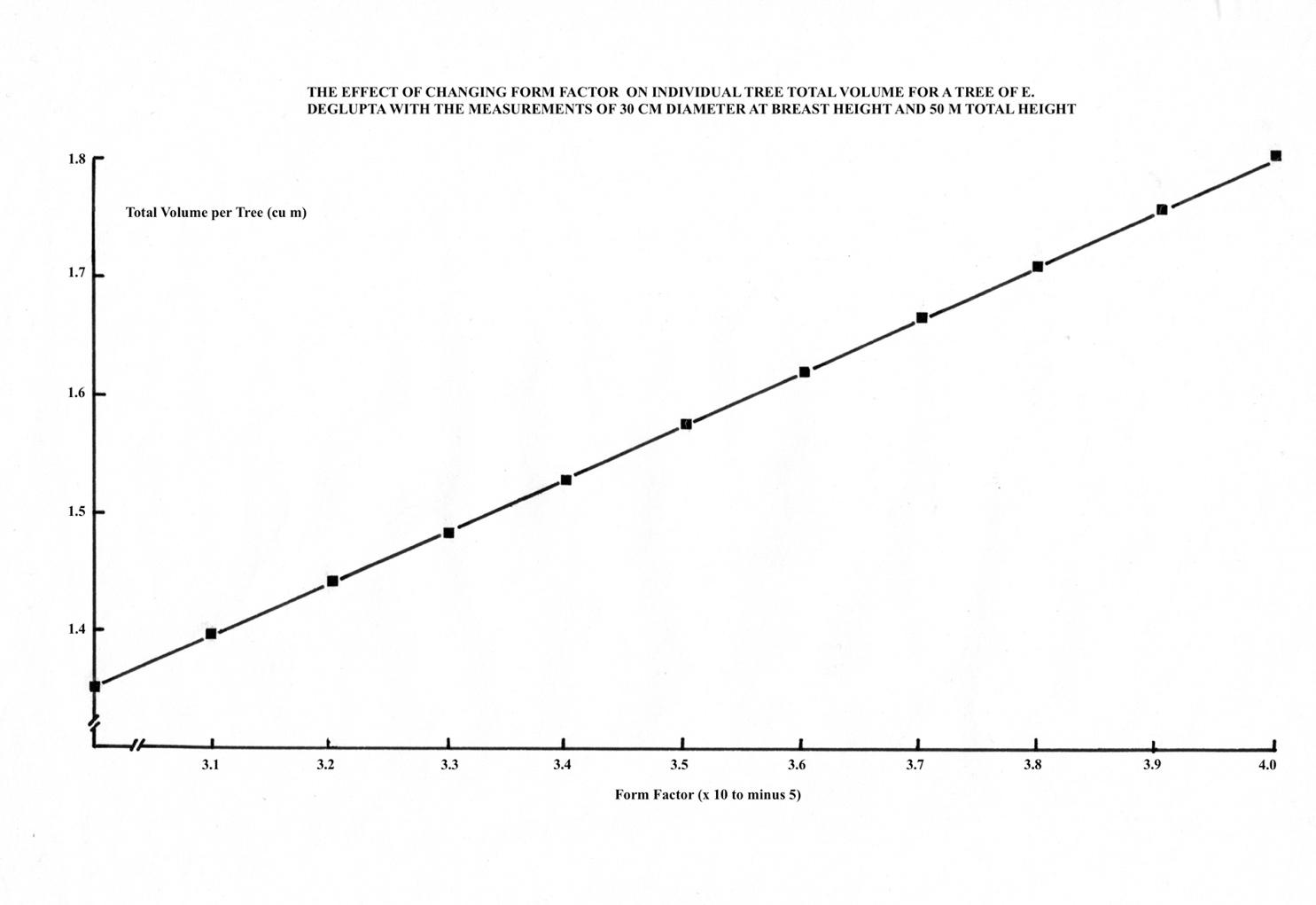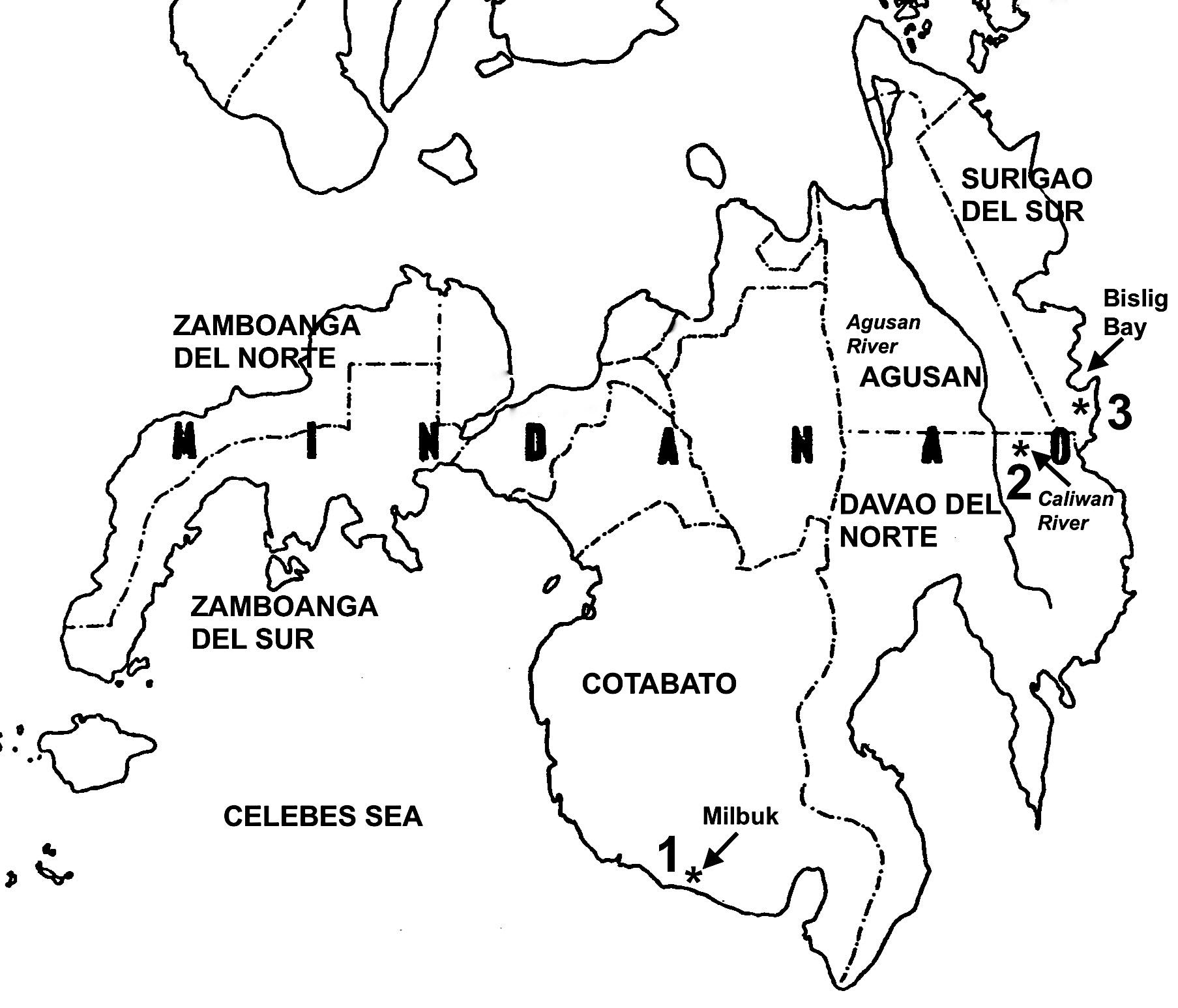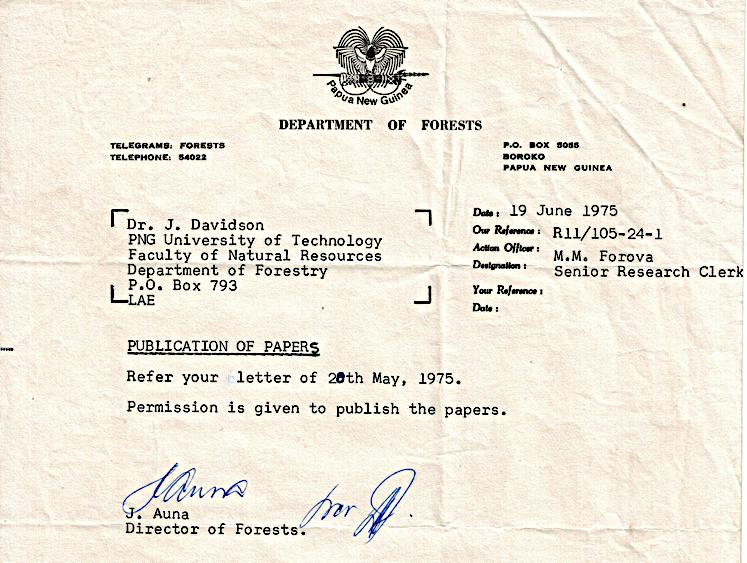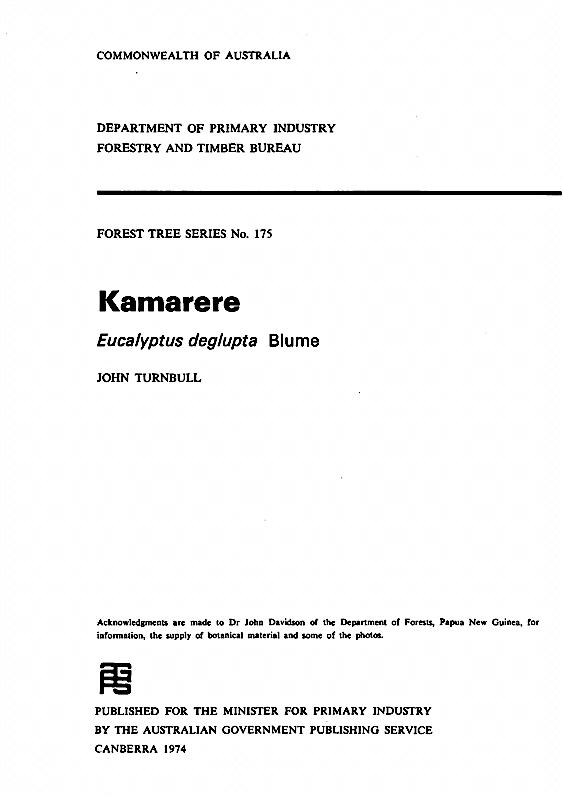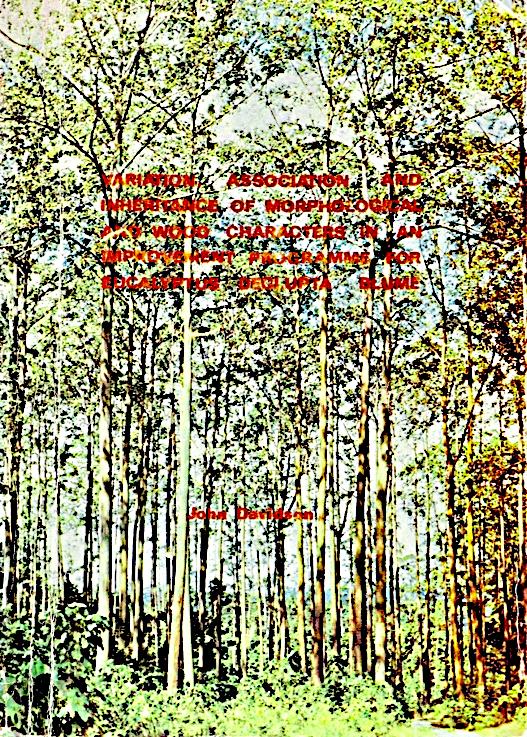
17 minute read
Natural distribution of E. deglupta
from PNGAF MAG ISSUE # 9 B-5B4D3 Dr John Davidson Accompaniment "RAINBOW EUCALYPT MAN" Part 6 of 8 parts
by rbmccarthy
The collection mission concluded there was a strong need for gene conservation of the Wissel Lakes population of E. deglupta. The population was morphologically distinct. The number of trees that was seen was relatively few. Natural regeneration was very poor. The overall impression was that the few remaining trees would soon disappear.
29
Advertisement
Natural distribution of E. deglupta
With the completion of the missions to Celebes, Ceram and Irian Jaya, I undertook an up-to-date assessment of the natural distribution of E. deglupta.
E. deglupta occurs between tropical latitudes 9°N and 11°S, in a markedly discontinuous distribution from longitude 119°E, through Mindanao in the Philippines, Sulawesi, Seram and West Papua in Indonesia, to longitude 153°E on New Britain in Papua New Guinea. The numbers in brackets in the following paragraphs refer to locations on the map (next page) and are cross-referenced to the listed herbarium specimens that support the distribution.
30
Philippines, Mindanao:
E. deglupta occurred in at least eight of the present-day Provinces of Mindanao: Zamboanga del Norte, Zamboanga del Sur, Sultan Kudarat, Cotabato, Misamis Orientalis, Davao del Norte, Surigao del Sur and Agusan. The best stands occurred near the Agusan River and its tributaries (3-5 and 7).
Along the Caliwan River (an east-bank tributary of the upper Agusan River) the species occurred from 400 – 950 m altitude, mainly confined to the valley floor on rocky alluvium. E. deglupta generally dominated the sites, with Casuarina (as the major associate), Pometia and Calophyllum species present. Regeneration of E. deglupta was variable, in some places from seedling to pole sizes, at others none, because of invasion by Dipterocarps.
Isolated large trees of E. deglupta existed on the lower slopes and were dominant on the valley floor on shallow sands and sandy loams over boulders along the Sumlug River in Davao Province.
29 The Paniai mountain villages became an increasing area of unrest and rebellion against Indonesian rule. 2,500 villagers were allegedly killed in 1985 and the forest areas where we made our observations and collections were burned by the military. 30 These sections are written in the past tense, except for Papua New Guinea where the present-day distribution has been verified. The collection history for E. deglupta goes back a considerable period of time and it is likely the species is no longer to be found in its natural state in some if not many of the locations where herbarium specimen and seed collections were made in the distant past.
Older trees reached 50 – 60 m in height in stands located 50 km south of Bislig Bay in Surigao del Sur Province. Profuse regeneration occurred on exposed sites, particularly road edges. Scattered, almost pure groups of various ages existed on landslide faces in this area.
Scattered groups occurred between 300 and 700 m altitude on upper slopes and on the valley floor along the Kraan River in Cotabato Province (6). Trees were present along rocky creeks and landslide faces. A variety of age groups was represented, from profuse young regeneration along roadsides to isolated large trees.
Isolated trees and scattered groups occurred on the valley floor and 10-20 m up the lower slopes along the Siocon River, 8 – 15 km from Siocon in Zamboanga del Norte Province. This area was subject to a severe dry season and large trees showed signs of moisture stress for part of the year. E. deglupta occurred in at least two river gorges, the Subayon and Kalibunan, both south-bank tributaries of the Cabadbaran River, rising on the slopes of Mount Hilonghilong, Agusan Province. Along the Subayon River, the species was very scattered and it is doubtful whether it would still form a viable breeding population. The valley floor was extremely narrow and rocky, most individuals occurred on landslides which extended over much of the sides of the gorge. In the Kalibunan gorge, topography was much more moderate and near-pure stands occurred, each comprising 30 – 40 medium to large trees. Form of these trees was poor.
Natural distribution of Eucalyptus deglupta Blume. Numbered black squares refer to locations mentioned in the text and in the listing of herbarium collections.
Herbarium collections: Mindanao. Zamboanga del Sur Province: (1)31 Caldera, near Zamboanga (Type of E. multiflora Rich (A Gray)), 1842, Rich25483 (GH):32(2) No other information, 1911, Merrill8063 (L); Agusan River catchment, New Bataan, 1968, Pryor15495 (G)–Sultan Kudarat Province: Milbuk, 1969, Cameron111005, 6 (LAE); Zamboanga del Norte Province: Siocon, 1969, Cameron111013 (LAE); AgusanProvince:(3) Cabadbaran, Mount Urdaneta (Type of Eugenia binacag Elm.), 1912 Elmer 13865 (K, L, GH, A); No other information, 1915, Soriano, Ponce and Valderama FB 24486 (PNH): (5) Tungao So., San Mateo Bo., 1961, Mendoza 41982 (PNH) – Cotabato Province: (6) Palimbam Valley, 1937, Henry, Aquino and Rodriguez 03778-80 (PNH) – Davao del Norte Province: (7) Agusan catchment, 1968, Pryor 15495 (G, LAE).
Indonesia, Sulawesi:
Between about one 1° North and 2° South latitudes, E. deglupta was found on the plains and coastal rivers (for example near Dumoga (12), Tapa, Palu (14), Ongka, Toli-toli (11), Balukan, Boloang, Kolawi, Saweiti, Tampak (25), Tibao, Ampibabo, Marantalo, Sausu, Pagowat (8), Lariang, Gorontalo, Kalonodale, Bongka, Ampana, Kabali, Batui, Poso (20) and Balanbal) and also at higher altitudes (for example at Gimpu and Pindolo).
Between 2° and 4° South latitude, the stands were scarce and small. They were mainly concentrated on the coastal plain from near Palopo (18), around the north of Bone Gulf, to Malili (21) (for example near Parara, Kaloukou, Tobou-tobou, Todantana Padang, Mario and Kandoa). One stand had been located on the swampy plains of the west coast (near Sampaga).
South of 4° South latitude, E. deglupta occurred rarely. Scattered, single trees were found along the Wempalle and Berong Rivers, which flow towards the west coast. The southernmost stand on Sulawesi was located at Parenglui (near Sungguminasa (26)) on the southwest peninsula at 5° 15’ South.
The oldest and largest trees were found near Tobou-tobou (65 – 80 m high, 40 – 45 m clear bole, 1 – 1.5 m diameter). The size of these trees impressed early botanists such as Reinwardt and Steup.
33
Herbarium collections: Sulawesi. North Peninsula: (8) Toludujuno, Pagowat River (Type of E. deglupta Blume), 1821, Reinwardt 1020 (L); (9) Batumotolohu, 1929, Moha 6, N I F S bb. 13801 (L); (10) Bulemo, Popaja, 1931, Sukarman 25, N I F S bb. 15714 (L); Toli-toli, Tende, 1940, Junus Mokodompit 2, N I F S bb. 32437 (L) – Central: (13) Donggala between Lindu and Kulaui, 1930, Postumus 2553 (L); (14) Palu River, Karopu, 1932, Bish 36, N I F S bb. 17000 (L, A); (15) Maleku, 1935, Wateurandang E, 69, 70, N I F S bb.19585-6 (L, A); (16) Malili, Maleku, 1938, Weismann E, 242 N I F S bb. 23907 (L); (17) Mangkulande, 1938, Tobing E, 313, N I F S bb. 25544 (L); (18) Palopo, Tampa, 1938, Gangsuy 32, N I F S bb. 24137 (L); (19) Kali Tokararu 6km east of Lake Lindu, 1939, Bloembergen 216, N I F S bb. 28256 (L); (20) Poso, Bantuga, 1940, Moh. Ali 4 N I F S bb. 31904 (L); (21) Malili, Maleku, 1940, Reppie N I F S bb. 32354 (L, A); (22) Maleku, 1941, Irot 57, N I F S bb. 32615 (L, A); (23) Tomoni, 1941, Irot 57, N I F S bb. 32618 (L, A); (24) Kampong Tampa, 1941, Mangopang 5, N I F S bb.33080 (L); Tampak River, 28 km South of Palopo, 1969, Larsen 20641, -43 -44 (FRI) - South-
31 Numbers in brackets in these sections refer to locations shown on the map of the geographic distribution of E. deglupta. 32 Abbreviations for herbaria follow Lanjouw J and Stafleu F A 1964 Index Herbariorum. Part 1: Herbaria of the World, Utrecht, Netherlands, except for “FRI” (Herbarium of the Forest Research Institute, Canberra) and “G” (Gauba Herbarium, Department of Botany, Australian National University, Canberra). 33 Reinwardt C G C 1856 in de Vriese, Plantae Indiae Batavae Orientalis (1):65, and Steup F K M 1931 Bijdragen tot de kennis der bosschen van noord – en midden Celebes. Tectona 24:1121-1135.
West Peninsula: (26) Sungguminasa, Malino, 1928, Burghardt N I F S bb. 12384 (L, BRI); (27) Gowa, Tombongi, 1940, Salverda N I F S bb. 32444 (L, A).
Indonesia, Seram:
On Seram (formerly Ceram), E. deglupta had been found at only a few sites on the northeast (28), east (29 – 32) and southeast (33) coasts. It was found along rivers, which are quite short (only 10 – 15 km long), arising in the high central mountains and flowing across a narrow coastal lowland strip (for example Samal, Matakabo, Boebi, Masiwang, Wahai, Tasikmi, Afing, Toloearang, Moeal, Isal, Lolo and Nif Rivers). E. deglupta had not been found in the western half of the island (west of the Wahai River) nor anywhere in the mountains of the island. The Agricultural Services in Ambon had documents reporting that the species occurred on the southeast coast of Seram, but no details were available on locations and appearance of those stands, the only definite record being the herbarium specimen collected from the vicinity of the Afing River (33) in 1918.
Herbarium collections: Seram. North: (28) Mual, 1917, Rutten 124 (L) – East: (29) Matakabo River, 1917, Rutten 328 (L); (30) Between Waru and Masiwang, 1918, Kornasi 984 (L); (31) Semos River, 1938, Buwalda 607 (L, A); (32) West Tasikmi, tributary of Samos River, 1938, Buwalda 5962 (L, BRI, A) – Southeast: (33) Afing River, 1918, Kornasi 991 (L).
Indonesia, Flores:
Christian Cossalter, in a report on an E. deglupta seed collection expedition in May 1975, mentions that Mr. Ardikoesoema, a forester from the Bogor Institute, had stated that natural stands of E. deglupta had been found on some mountains in the western part of Flores, in areas where rainfall is particularly high. If this information was correct, the natural limit of E. deglupta in Indonesia would reach 8°30' S, close to the northwest limit of the range of E. urophylla. Provenances from Flores would be, with provenances from Papua New Guinea, the least equatorial within the entire species range.
34
Indonesia, Irian Jaya:
Until 1975, only three collections had been made from Irian Jaya.35
These were made in the Wissel Lakes area (now Lake Paniai) (35, 36), and one from the Vogelkop Peninsula (34).
36
In June 1975 Doug Boland of the CSIRO Tree Seed Centre and I made new collections of specimens including buds, flowers, fruits
34 See Cossalter C 1977 Location and ecological data of some provenances of Eucalyptus deglupta Blume in the Celebes and Ceram Islands – characteristics of the natural stands. Forest Genetic Resources Information, FAO Rome 6:16-23. On a visit to the central and western parts of Flores in 1987 I was unable to locate any natural E. deglupta, but planted E. urophylla was quite common. There is no typical signature of any riverside E. deglupta visible on present day satellite imagery of western Flores. 35 Now Papua and West Papua Provinces, Indonesia (see map). The Lakes area is at the western end of the central cordillera in Papua. 36 Also now known as Bird’s Head Peninsula, Kepala Burung, or Doberai Peninsula in West Papua.
and seed from areas north of Lake Paniai (see earlier).
37
In the mountains the main occurrence was between 1,600 and 1,800 m altitude. Near the village of Mutitoh, E. deglupta occurred in broadleaf forest on mountain slopes along the Boro River at about 1,850 m altitude. This species was observed at several other places on nearby mountain slopes and ridges between 1,600 and 1,900 m altitude. Groups of E. deglupta occurred on a few steep ridges along the North Erome Valley and in the flat but narrow upper reaches of the Doria Creek (Kebo Valley) where it flows out of the high mountains (for example, Morauglito Summit: 2, 340 m altitude) and at Moritok, near Kebo.
Little is known of the extent of E. deglupta on the Bird’s Head Peninsula. The specimen (7946) was collected among trees growing at 1,800 m altitude in a riverain situation (Andjai and Wekari Rivers) and associated with Nothofagus sp – conifer forest.
Leaf shapes of the specimens varied among the three locations. The collections by Zieck and Van Royen and Sleumer have ovate-lanceolate leaves while the more rounded leaves of Eyma’s specimen are similar to those of specimens from the West Sepik District of PNG, for example from Ossima and Kilifas.
Herbarium collections: West Papua. Bird’s Head Peninsula: (34) Nettoti Range, East slope of Mount Nettoti, headwaters of Andjai and Wekari Rivers, 1961, Van Royen and Sleumer 7946 (LAE) – Lake Paniai: (35) Bogesiga, 1939, Eyma 5360 (L), (36) Kebo, 1960, Zieck BW 3286 (L, CANB). Near Koebejo River, Wissel Lakes (35), Irian Jaya, altitude 1,850m, 10 June 1975, Davidson 1010 (WL1), (LAE, FRI); Near Koebejo River, Wissel Lakes, Irian Jaya, altitude 1,825m, 11 June 1975, Davidson 1011 (WL2), (LAE, FRI); Near Kebo, on slope near Koebejo River, Wissel Lakes, Irian Jaya, altitude 1,850 m, 12 June 1975, Davidson 1012 (WL3), (LAE, FRI); Near Kebo, on the bank of the Koebejo River, Wissel Lakes, Irian Jaya, altitude 1,750 m, 12 June 1975, Davidson 1013 (WL4), (LAE, FRI); Near Kedergboetoe, Wissel Lakes, Irian Jaya, altitude 1,750 m, 12 June 1975, Davidson 1014 (WL5), (LAE, FRI); Near Koebejo River, Wissel Lakes, Irian Jaya, altitude 1,850 m, 13 June 1975, Davidson 1015 (WL6), (LAE, FRI); Koebejo Valley, near Kebo, Wissel Lakes, Irian Jaya, altitude 1,750 m, 14 June 1975, Davidson 1016 (WL7), (LAE, FRI).
Papua New Guinea:
In eight districts of Papua New Guinea, E. deglupta occurs naturally; West Sepik (37 – 39); Eastern Highlands (40 – 41); Chimbu (42, 43); Western Highlands (44 – 45); Morobe (46 – 49); Milne Bay (50 – 52); West New Britain (53 – 57) and East New Britain (58 – 73). Best development of the species is found on New Britain. There, E. deglupta has extensively colonised recent volcanic deposits and landslide areas as well as sandbanks along more than 20 major streams. An interesting occurrence is found up to the tree line at 1,370 m altitude on the slopes of Mount Ulawun, an active volcanic cone rising from sea level to 2,298 m altitude in less than 10 km distance. Further information on locations,
37 Boland D, Davidson J and Howcroft N 1977 Eucalyptus deglupta Blume and Araucaria cunninghamii Lambert provenance seed collection in Irian Jaya, Indonesia, 3 – 17 June 1975. Forest Genetic Resources Information. FAO Rome 6:3-15.
factors affecting distribution and of forest types and associations in which E. deglupta occurs in Papua New Guinea is available from early parts of this report and from several other sources.
38
Herbarium collections: West Sepik District: (37) Ossima, 1964, Sayers NGF 18009 (LAE, L, CANB, A, K, BOG, SING, SYD, UH, PNH, US); (38) Ossima, 1968, Davidson 303, 4 (LAE); (39) Southeast of Kilifas, Amanab, 1970, Foreman and Kumul NGF 48348 (LAE) – Eastern Highlands District: Mt Wilhelm, east slopes, 1959, Brass 30764 (LAE); (40) Watabung, 1962, Simonett 42779 (LAE); (41) Keglsugl, 1964, Millar NGF 23161 (LAE, L, CANB, A, K, BOG, SING, SYD, UH, PNH, US, BISH, BRI) – Chimbu District: (42) Kerowagi, 1968, Davidson 300 (LAE); (43) Koge Mission, Sina Sina, 1972, Hide 65, 66, NGF 3327 (LAE,L); Gembogl, 1966, Wade ANU 7495, 80378 (LAE) – Western Highlands District: (44) Nondugl, 1951, Womersley NGF 4367 (LAE, L); (45) Jimmi Valley, 1967, Street and Manner 311 (LAE) – Morobe District: (46) Jaduna, Waria River (Type of E. schlechteri Diels), 1909, Schlechter 19242 (K); (47) Morobe River, 1948, Womersley NGF 3134 (LAE); (48) No information other than “type locality E. schlechteri, Anonymous 8404 (LAE); (49) Saru River near Garaina, 1971, Howcroft NGF 25946 and -49 (LAE) – Milne Bay District: Milne Bay, 1968, Pryor 101000 (LAE); Milne bay, 2 miles upstream Kutu River, Raba Raba, 1968, Pryor 101001 (LAE); (50) Kigara River, 1968 Arenz 105865 (LAE); (51) Ulumanu River, 1968, Arenz 105864 (LAE); (52) Raba Raba, 3 km upstream on the Kutu River, 1968, Pryor (G); Kaibola Village, Milne Bay, 1972, Frodin UPNG923, 233921 (LAE) – West New Britain District: (53) Gasmata, Whiteman Range, upper Johanna River, 1966, Frodin NGF 26501, 2 (LAE, L, CANB, A, K, BOG, SING, SYD, UH, PNH, US, BISH, NEW YORK, BRI); (54) Hoskins, 1968, Pryor and Davidson 101602-3, 10 (LAE); Ko River near Hoskins, 1970, Davidson FRI 20348 (BRI); (55) Malilimi, 1972, Davidson 521 (LAE); Toiru River near Bialla, 1972, Davidson 511 (LAE); Wilelo, 2 km inland, 1973, Stephens and Lelean 206898, 58605 (LAE,L, CANB, A, K, EDINBURG, MUNICH SYD) – East New Britain District: (58) Spacious Bay (Type of E. naudiniana F. Muell.), 1879, Turner (MELB, BRI); (59) Korindal, 1924, Lane-Poole 797 (L, CANB, BRI, B); (60) Waterfall Bay, 1938, McAdam 94 (LAE); (61) Bulus River, 1945, Mair NGF 1823 (LAE, L, BRI, CANB); (62) Jacquinot Bay, 1945, Anonymous NGF 149 (LAE, BRI); (63) No further information, 1949, Heather 8399, 8403 (LAE); Unai River, Fulleborn Harbour, 1965, Sayers NGF 21827 (LAE, L, CANB, A, K, BOG, SING, SYD, PNH, BISH); Unai River Fulleborn Harbour, Kandrian 1966 Sayers NGF 26501 (LAE); (65) Sai River Pad 10, 1967, Davidson 258 (LAE); (66) Pad 2, 1967, Davidson 256 (LAE); Sai River (Open Bay Timber Area), 1975, Kumul NGF 38149, 38153 (L, CANB, A, LAE, K, BRI); Sai River (Open bay Timber Area), 1975, Kumul and Eddowes NGF 38153 (LAE); (67) Keravat River, 1968, Pryor and Davidson 101607, 9 (LAE); (68) Vudal River, 1968, Pryor and Davidson 101604 – 6 (LAE); (69) Asrogi River, 1972, Davidson 516 (LAE); Toriu River, 1972, Foreman 52166 (LAE, L, CANB, A, K, BOG); (71) Sai River 1972, Davidson505 (LAE); (72) Coppice, Sai River, 1972, Davidson503 (LAE); Aiwit Rivereast of Fulleborn Harbour, 1973, Croft and KatikNGF 14986 (LAE, L, CANB, A, K, SYD, BISH, US, ED, MUN, ATHERTON); (74) Keravat River, 1974, Davidson 511 (LAE); Gazelle Peninsula, 1894, Schmiele (LAE, BRI); Keravat, sent to Canberra for illustrating Forest Tree Leaflet No. 175, 1974, Davidson (CANB).
Diels in his account of E. deglupta (as E. naudiniana)
39
cites a specimen from New Ireland as follows (translated): “Namatanai, near Vuna Marita, 70 m high tree. Local name “Kumurere” (Peekel n. 708 …. 19. November 1910)”. This citation probably has been responsible for several references to New Ireland being part of the natural distribution pattern for E. deglupta (for example, see Maiden 1903 – 1933 and Ferguson 1950).
40
There is no Vuna Marita near Namatanai. The prefix Vuna is not applied to any place names in that region of New Ireland but is common, however, on the Gazelle Peninsula, New Britain. The quoted local
38 Including Davidson J 1972 loc. cit. and Davidson J 1973 A description of Eucalyptus deglupta. Tropical Forestry Research Note SR7, Department of Forests, Port Moresby. 39 Diels L 1922 Die Myrtaceen von Papuasien. In Engler A (ed) Botanische Jahrbucher 57:423. 40 Maiden J H 1903-1933 A critical revision of the genus Eucalyptus, 8 volumes, Government Printer, Sydney; and Ferguson J H A 1950 Eucalyptus deglupta Blume. Tectona 40:51-61.
name “Kumurere” seems very similar in pronunciation to the Tolai name “Kamarere”, and the Tolai are the indigenous inhabitants confined to the Gazelle Peninsula and are not from New Ireland.
Peekel paid an extended visit to New Britain in 1910, the year when his specimen 708 was collected.

The National Herbarium of Papua and New Guinea was located in the building housing the Division of Botany, Department of Forests, in the grounds of the Lae Botanical Gardens, and seen here in 1972. It was opened on 12 April 1965.
41
Some maps of the Gazelle Peninsula, for example Department of Lands, Surveys and Mines 1956, reveal a mission station known as Vuna Marita on the north Bainings coast near Massawa and this is probably the correct locality of Peekel 708. Peekel, in his description of E. naudiniana, himself states that the species was found only on New Britain in the Bismarck Archipelago.
42
The Reverend G Brown was reported to have seen eucalypts in New Ireland during his missionary travels
43
but it is not known whether these were planted trees or not and no contemporary evidence is available to support his observation. Extensive recent aerial surveys, even in such likely locations as the Weiten – Kamdaru
41 Van Steenis C C G J - Kruseman M J 1950 Cyclopaedia of Collectors. In Van Steenis C C G J (ed) Flora Malesiana 1(1), Djakarta. 42 Peekel P G 1947 Illustrierte Flora des Bismarck – Archipels fur Naturfreunde (MS) 7:1341-1342. Original is in the Library of the Provinzialat of the Sacred Heart Mission, Wesphalia, Germany. A copy was held in the Library of the National Herbarium in Lae PNG. 43 See Von Mueller F 1886 Description of a hitherto unrecorded species of Eucalyptus from New Britain. Australasian Journal of Pharmacy 1(7):239-240.

